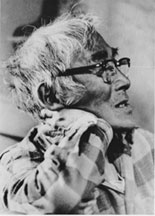Return to Iñupiaq Perspectives Page
George & Nora Agiak
 |
George was born on Christmas Eve, 1909, in Utqiaġvik (Barrow). His mother’s name was Tuuluq. She was a sister of Richmond and Susie Ologak, and of Paul Patkotak, who were all children of Adam Alisuarak and Eve Kignak. George’s father, who was also named George Agiak, died before the younger George was born - that is why George is named after him. His mother remarried and his stepfather’s name was Aġnik. George lived at Wainwright until he was twelve years old. Agiak’s stepfather Aġnik and his mother Tuułuq had a residence at Sikł̣aqtitaq (Point McIntyre) on the west side of Prudhoe Bay. George used to travel from here over to the Colville River to fish. One time, before he was married, he caught two thousand fish at the Colville. George also used to stay with Taaqpak. They used to fish for sulukpaugaq (grayling) in the Kuparuk River. George stayed at Kuukpaġruk several different years. Nora was born in Utqiaġvik on November 26, 1911, and lived the first five and one-half years of her there. Her parents were Tom and Agiak Gordon. Tom was a white man from Scotland who came to Utqiaġvik during the whaling days. He was a whaler and trader there for several years, working with Charles Bower. Agiak was originally from the Utuqqaq River country. In the summer of 1917, Tom Gordon moved his family to Demarcation Point. Here he built a log house, and established a fur trading outpost for H. Liebes and Company, which was the same San Francisco furhouse that Charles Bower represented. Agiak’s brother, Andrew Akootchook, also moved there with his family at the same time. George and Nora were married at Barter Island in 1931. The next year they moved over to Sikł̣aqtitaq. Their oldest living child, Mae Suakpak, was born at Sikł̣aqtitaq on January 19, 1935.Nora first met the Presbyterian minister, Fred Klerekoper, shortly after this time. He was traveling with Walter Ipalook, and they stopped at Sikł̣aqtitaq. George was on a trip that time, so he didn’t see him. The Agiaks lived at Sikł̣aqtitaq off and on every year until 1943. In the wintertime, they would usually travel inland to hunt and fish. Their daughter Mae remembers the fishing trips they made it Kuukpaaġruk, on the Kuparuk River, and to Sigsinak, on the Shaviovik River. They also fished and hunted on the Sagvaġniqtuuq River. Mae remembers that the sulukpaugaq that they used to catch in the Kuparuk River were especially big and fat. In the late 1930’s, the Agiaks made their first trip up to Qani, in the mountains at the head waters of the Hula Hula River. They spent about two months up there. As well as making trips to Barter Island, the Agiaks would also make an occasional trip to Beechey Point for trading. They knew the traders Jack Smith, John Olson, Gus Masik, and Captain C.T. Pederson. Their sixth child, Tommy Aġnik Agiak, was born on November 26, 1943, in a small house that they had built way inland on the Shaviovik River. (This river is called the Kavik River on the USGS map, and it is a tributary of the Shaviovik River). Around this time, Jack Smith died of a heart attack and Henry Chamberlain moved away, meaning that both the Beechey Point and Agliġuaġruk (Brownlow Point) trading posts closed down and the Agiaks no longer had anywhere to trade their fox skins for necessary store items. Their friend, Paul Koyutak (father of Annie Soplu of Kaktovik), told them they ought to move to Herschel Island, Canada, where they would be closer to a trading post. So in the fall of 1944 they decided to do this. (pg. 95-97) |

